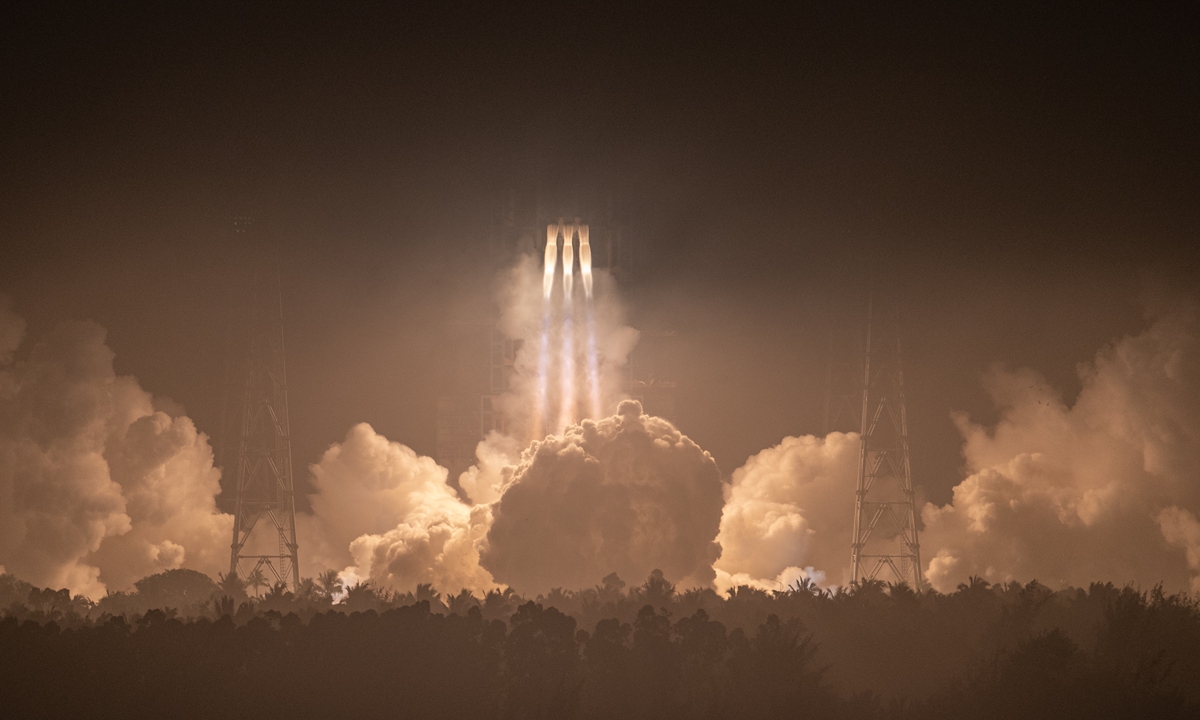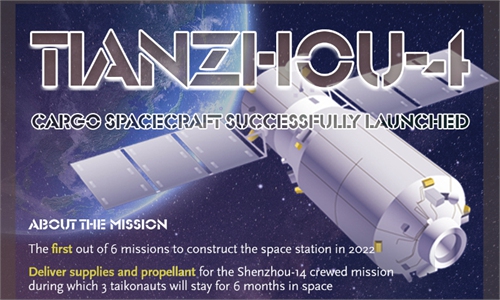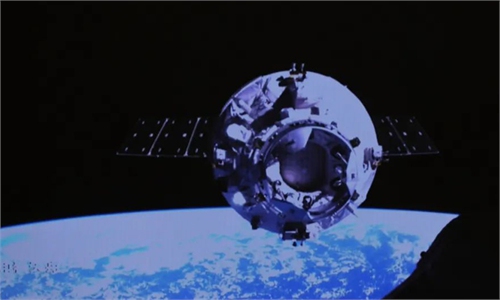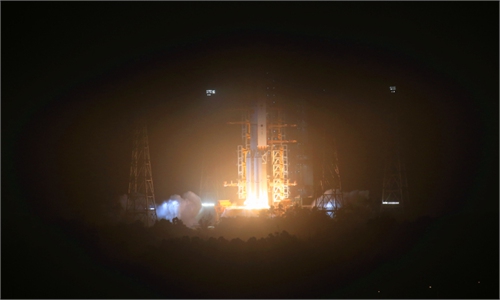Tianzhou-4 cargo spacecraft delivers supplies to Tiangong in 1st of six China Space Station construction missions

The Tianzhou-4 cargo spacecraft rides atop the Long March-7 Y5 carrier rocket as it takes off from the Wenchang Spacecraft Launch Center in South China's Hainan Province at around 1:56 am on May 10, 2022. Photo: VCG
With a mission to ferry supplies for the upcoming Shenzhou-14 manned spaceflight mission and materials for the in-orbit assembly of the Tiangong China Space Station, the Tianzhou-4 cargo spacecraft successfully carried out an automatic and fast rendezvous and docking with the orbital space station combination on Tuesday morning, some seven hours after its launch.
The ultra-fast and smooth rendezvous and docking by the spacecraft took place at 8:54 am on Tuesday, after it was launched with a Long March-7 Y5 carrier rocket that took off from the Wenchang Space Launch Center, located in South China's Hainan Province, on Tuesday around 1:56 am, the China Manned Space Agency (CMSA) said in a statement.
Similar to the previous cargo mission launched in September 2021, it docked at the rear of the core module, joining the in-orbit Tianhe and Tianzhou-3 space station combination, the CMSA revealed. The Tianzhou-2 mission, which was the first supply run heading toward the space station, detached from the core module about a month ago after accomplishing its mission.
According to the spacecraft developer, the China Academy of Spacecraft Technology (CAST), the Tianzhou-4 carries more than 200 parcels of cargo weighing some 6.2 tons, which will supply the astronauts, space station systems and space application domains. Propellants totaling 750 kilograms are also onboard.
One of the highlights in this supply run is a set of replacement parts for the station's urine treatment system, which turns urine into water and supports the long-term stay of astronauts in space.
The system has processed nearly 1,700 liters of urine and produced more than 1,400 liters of distilled water in the past year in orbit, which has fully verified the stability and reliability of its functions, the Global Times learned from the system's developers - the 206 Research Institute of the Second Academy of the China Aerospace Science and Industry Corp (CASIC).
The cargo ship also possesses capabilities of controlling the space station's flight form and orbit, providing remote monitoring and data transmission services to the space station, and supporting in-orbit science experiments.
"Our cargo ship is characterized by a much higher load capacity than any other spacecraft in service," Song Zhongping, a space analyst and TV commentator, told the Global Times on Tuesday. "Tianzhou-4 weighs about 13 tons, and is able to carry a payload of six and a half tons. This ratio is higher than any other cargo spacecraft in the world, indicating that China's overall design is relatively advanced."
China's cargo spacecraft aims to become more "user-friendly," and more automated, even including artificial intelligence in the management of goods carried onboard, Song noted.
Tianzhou-4's journey to space and its docking operations were secured by a "sky road" established by the "handshake" of a relay terminal and satellites, the CAST said in a statement it sent to the Global Times.
By establishing a space-based telecommunications system, the relay terminal can simultaneously "remote pilot" the Tianzhou-3, Tianzhou-4 and the Tianhe core module, transmit data such as images of rendezvous and docking to the ground in real time, and provide communications support for the entire process.
Once the telecommunication link is established, the ground's control and monitor coverage rate of the Tianzhou-4 will be improved by more than 90 percent, ensuring that the craft can stay in touch with the ground most of the time, CAST revealed.
The Tianzhou supply series has experienced a significant reduction of rendezvous and docking time over the years. The first Tianzhou mission, which launched and docked with China's Tiangong-2 space lab module in 2017, took about two days. The second mission of Tianzhou-3 in May 2021 took a mere eight hours to achieve the same feat.
Having reduced the docking time to 6.5 hours, deputy chief commander of the cargo spacecraft Li Zhihui told media that they are looking to further shorten it by 4.5 hours. "From the moment it is launched, it will only take two hours and 15 minutes to dock with the space station," Li said.
Being a fully sealed spacecraft, Tianzhou-4 is by far the world's largest in-service cargo spaceship with the most comprehensive in-orbit support capability, the CAST noted.
The CAST also made improvements based on suggestions from taikonauts who have visited the space station. For example, to facilitate taikonauts who are searching for goods in-orbit, Tianzhou-4 has added labeling designs and applied colors to packages' handles.
Dang Rong, deputy chief designer of the craft, told the Global Times that Tianzhou-4 also carried a payload for special experiments and would release a satellite as part of the process.
It was the fourth time that the 53.1-meter-long, 3.35-meter-diameter Long March-7 rocket had carried its Tianzhou passengers into space. Having established perfect coordination between the two space buddies, the rocket's flight reliability assessment value has reached 0.9838, an internationally advanced level, indicating a stabilized overall technical status of the rocket.
For this mission, the first run to China's space station core module this year, the rocket has had 17 technical upgrades, optimizing pre-launch processes, shortening preparation time, and reducing the requirements for personnel, equipment, weather and other conditions.
Through these changes, the rocket's test and launch cycle has been reduced by four days previously to 27 days now. This is also the first time that a Long March-7 rocket has been tested and launched within one month.
The Tuesday mission marked the first of the six space station-building launch missions in 2022. By the end of the year, the China Space Station will be fully built and operational.
With 2022 marking the 30th anniversary of the establishment of the country's manned space engineering project, the completion of Tiangong is a key target of the three-step strategy, and an important symbol of China becoming a strong space power in the world, Hao Chun, the director of the CMSA, revealed at a press conference following the triumphant return of Shenzhou-13 crew in mid-April.
The six flights are the Tianzhou-4 cargo spacecraft, another supply run for the next shift, launched Tuesday; the Shenzhou-14 manned mission in June; the Wentian experimental module in July; the Mengtian experimental module in October; another cargo mission, the Tianzhou-5, and a manned mission, the Shenzhou-15.
The Shenzhou-14 and -15 manned missions, which will each carry a crew of three members, will meet and stay together in the station for about five to 10 days when the two crews rotate, said Huang Weifen, head of the taikonaut training system at the same press conference. It means that China's space station will have, for the first time, six taikonauts staying in orbit at the same time, testing the station's maximum capacity for short-term human stays.




